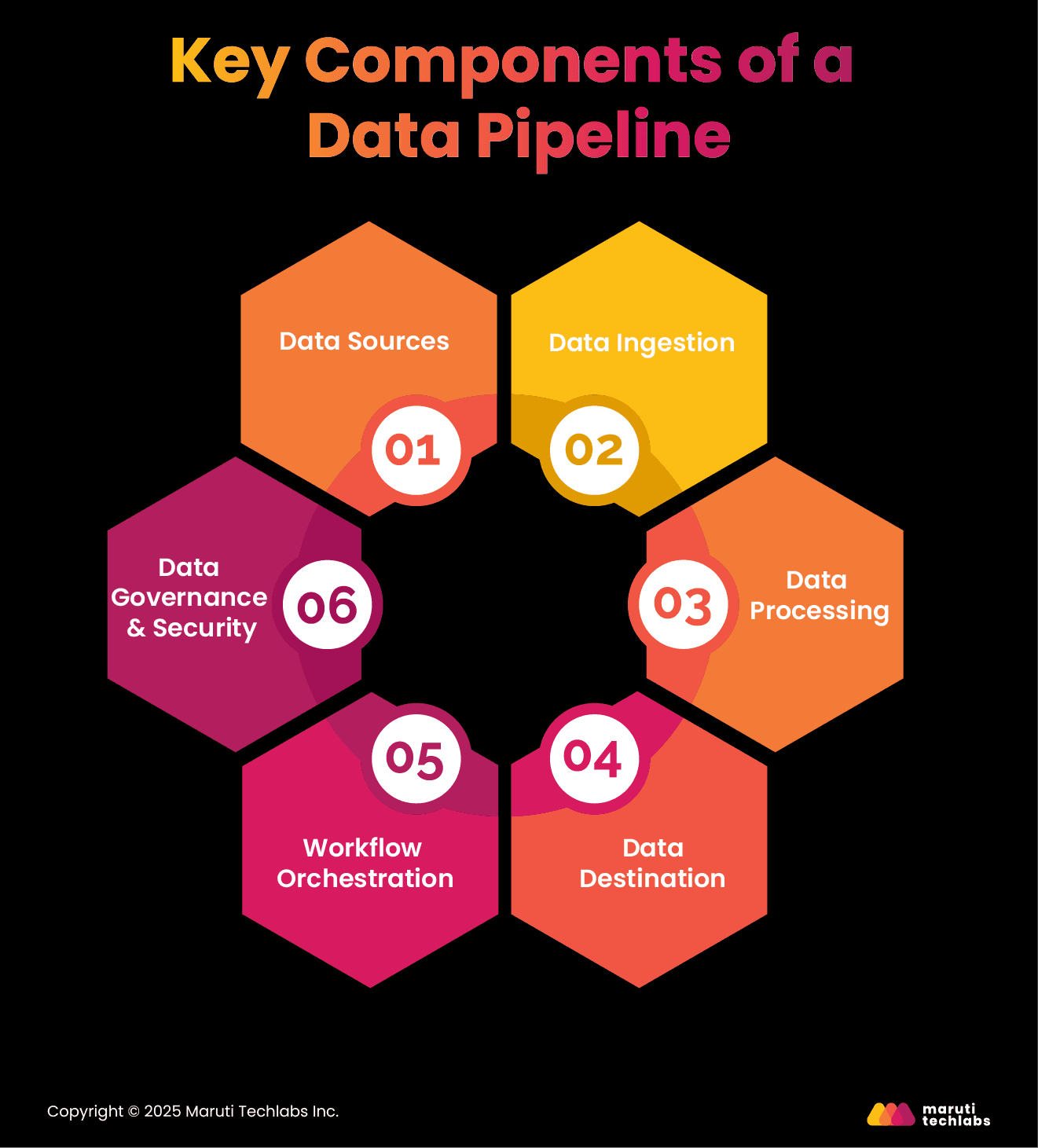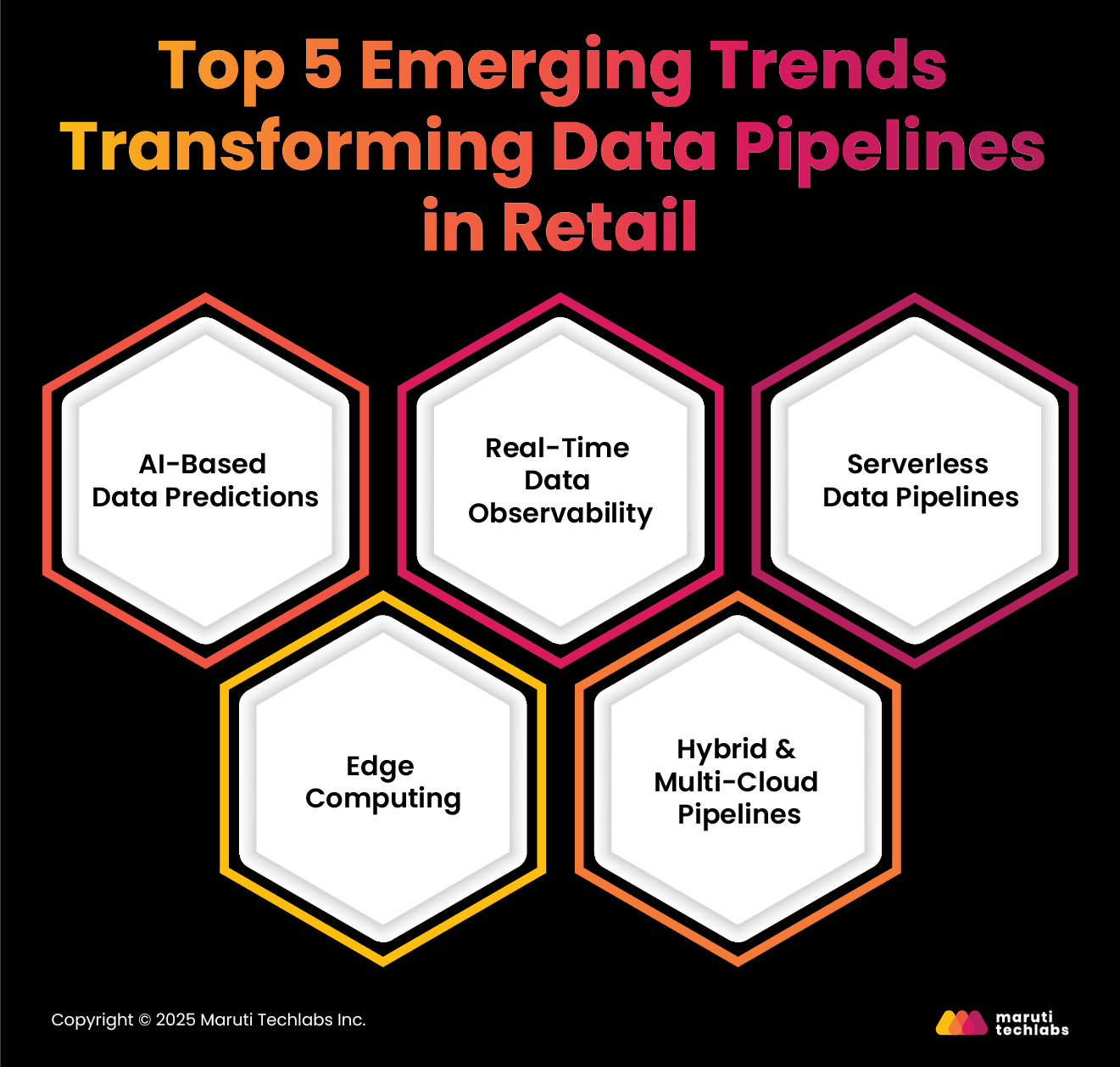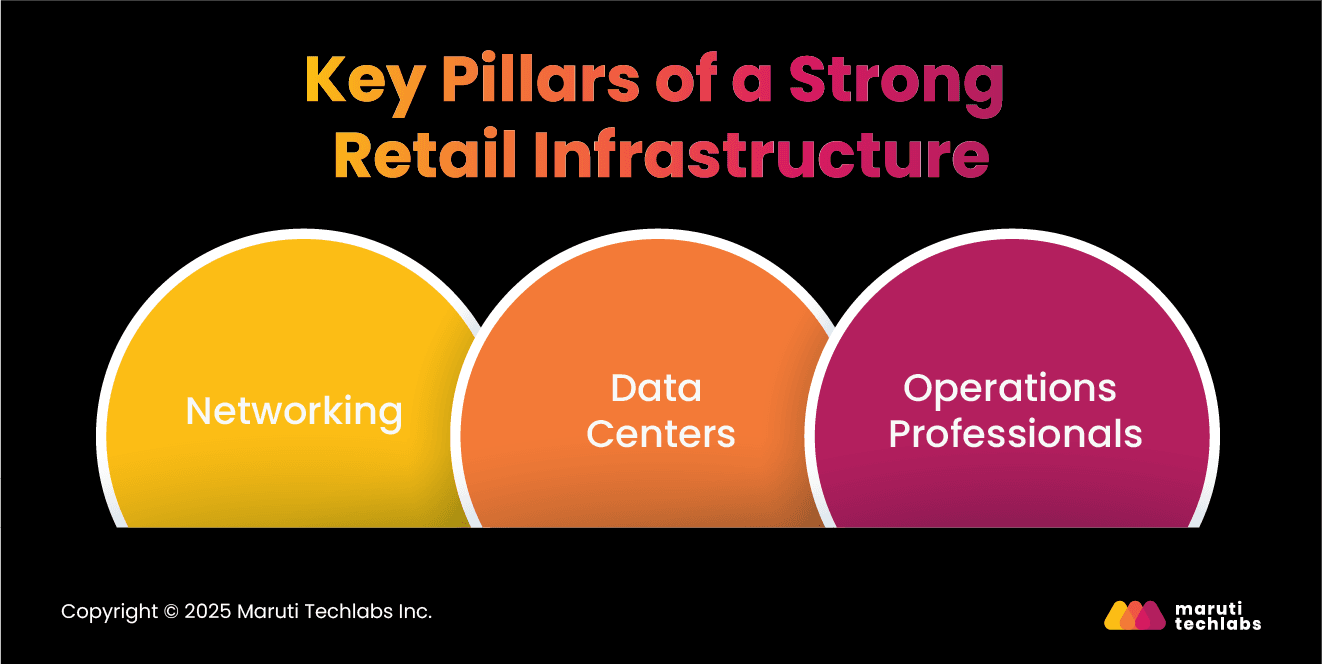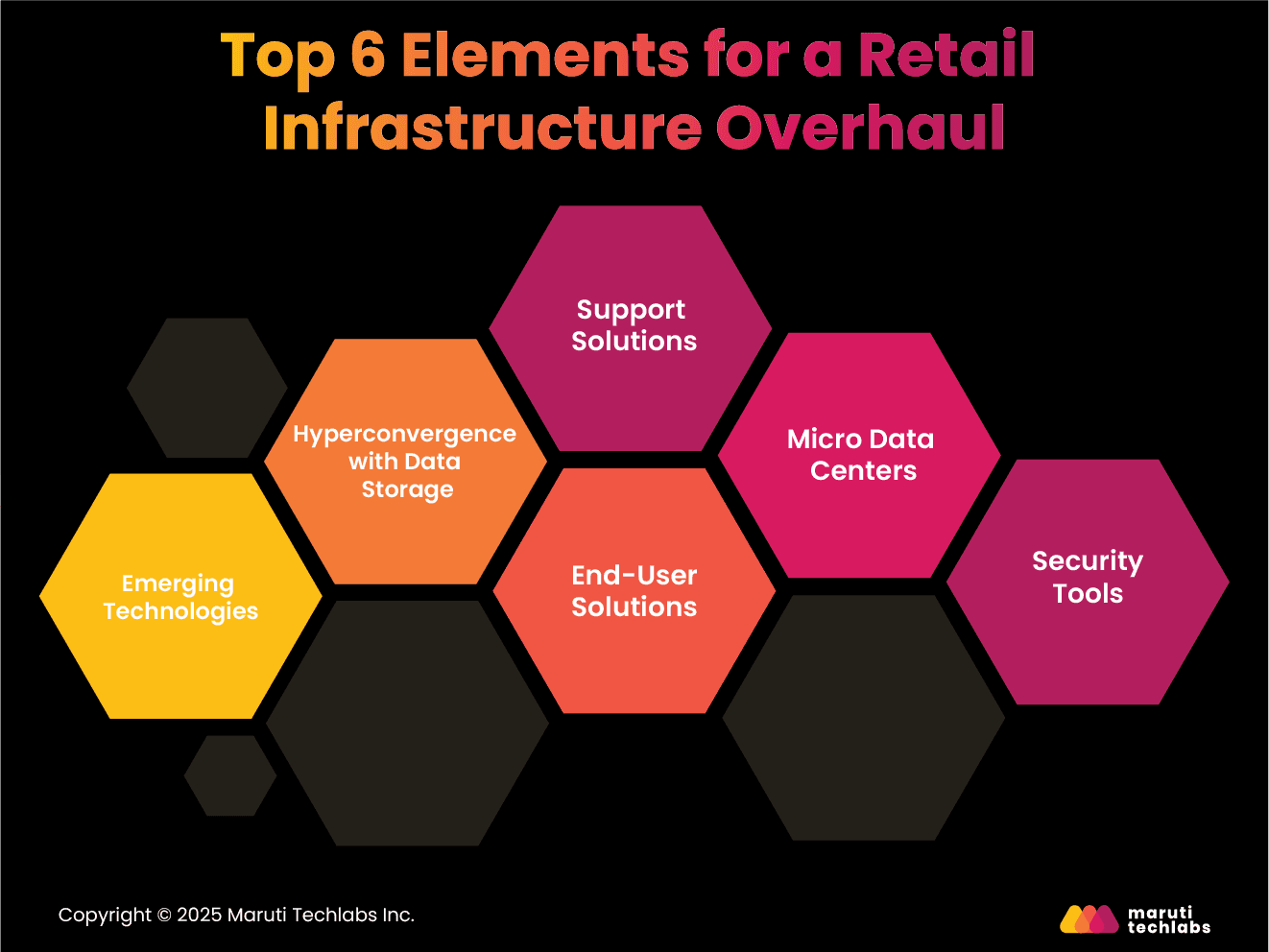

The Ultimate Guide to Building a Future-Ready Retail Infrastructure






The retail universe is ever-evolving, and the line between online and offline experiences continues to blur with time. A retail store may have numerous physical outlets and great repute, but it’s imperative for them to offer seamless digital experiences while marketing via different channels.
All these numerous touchpoints generate data that must be collected, stored, segregated, and analyzed. The structured data can streamline operations and logistics, inventory management, and discover new opportunities to enhance customer service.
However, conducting the above processes with ease requires a dynamic and futuristic retail IT infrastructure equipped with data pipelines that capture every activity. This blog offers insights into key components and emerging trends with data pipelines and crucial elements for a strong retail infrastructure in 2025.
Data pipelines create frameworks that automate data flow from a source to its destination. This data is then processed and analyzed to make data-driven decisions. Data pipelines streamline numerous data streams in the retail industry, from inventory and customer transactions to social media analytics.
Data pipelines help retailers effectively use their data assets, offering crucial insights, personalizing customer experiences, and predictive analytics. This structured data offers many strategic benefits, such as refining marketing strategies, forecasting demand, managing inventory, and revamping customer engagement across all channels.
A data pipeline enables the efficient movement, transformation, and management of data across systems for analysis and decision-making. The following components play a significant role in creating a compelling data pipeline.
These are the essential touchpoints, which include APIs, databases, and IoT devices. Retail chains must monitor different channels for a holistic view of stock and marketing.
This involves leveraging data ingestion tools to collect data from numerous sources. Companies may use batch processing for scheduled tasks or real-time streaming to capture data instantly. Sports platforms employ continual ingestion, providing real-time game statistics and facilitating quick decision-making for broadcasters and fans.

Here, raw data is cleaned, normalized, and converted into a usable format. For example, by tracking the data of various suppliers, a global logistics company ensures timely shipments and quick issue resolution.
Data warehouses or lakes store processed data for analysis. Companies like Airbnb boost user experience and revenue by leveraging technologies like Big Data to facilitate dynamic pricing, personalize recommendations, and maximize occupancy rates across listings.
Tools like Apache Airflow can track the sequence of these tasks. They ensure seamless data processing. E-commerce giants use these tools to track campaign performance across different channels and foster data-based optimization.
As a final step, data reliability, compliance, and security are crucial. Organizations take stringent measures, using encryption and access control, to prevent breaches that can lead to legal and financial repercussions.
AI-driven automation, real-time analytics, and cloud-native architectures are making retail data pipelines faster, more scalable, and cost-efficient.

Here are the emerging techs making data pipelines more scalable, efficient, and adaptable.
AI accounts for intelligent and coherent pipelines as they predict issues with data quality and suggest corrections. Businesses today want to ensure their data is ready for real-time analytics and incorporate AI models to pre-process large datasets.
These tools allow businesses to detect and resolve issues before they cause any disruptions or downtime, providing real-time observability.
With the shift toward serverless architecture, data processing has become cost-efficient and scalable. Startups can save costs by not investing in on-premise infrastructure, providing flexibility with their data needs.
As a considerable amount of data is being generated at the network edge (e.g., IoT devices), edge computing is gaining a lot of traction. Tesla makes ample use of this, reducing latency and improving decision-making by processing data from sensors directly at the vehicle level.
Companies today want to avoid vendor lock-in, increase resilience, and opt for hybrid and multi-cloud environments.
Retailers today have to stay afoot with the evolving technology to drive customer engagement. Offering the latest tech allows retailers to set themselves apart from their competitors. However, it must have an adequate infrastructure to support these new advancements. These technologies only provide the desired experiences and benefits if backed by essential retail infrastructure.

These are the 3 areas that account for a strong IT retail infrastructure.
Networks are the backbone of all in-store technology. Essentials like POS systems, machine-to-machine communication, inventory, digital signage, mobile devices, and other techs need a strong network to function at their peak. Adding to the above requires more bandwidth.
Retailers must anticipate current and future bandwidth requirements to facilitate a seamless experience. Today, retailers also provide Wi-Fi access. However, this requires thoughtful planning to prevent intrusions and security concerns on store systems. The unavailability of a fast, efficient, and reliable network can risk retailers' operations and result in unsatisfactory customer experiences.
Retailers manage vast amounts of data, including inventory, staff records, customer details, transaction history, and more. Therefore, their data storage systems must have the resilience, security, and scalability to handle this load.
While on-prem infrastructure is the go-to solution for any business, retailers today are widely adopting or migrating to the cloud. The cloud offers autonomy over scalability and flexibility to use on-demand resources.
In addition to addressing their storage needs, the cloud helps segregate data and extract potential customer insights to better their business offerings.
Investing in IT infrastructure combined with the latest technologies can significantly benefit retailers. However, their real challenge is to find ways to implement new technologies without disrupting their existing systems.
The only viable solution to this problem is leveraging the skills and expertise of business technology consultants. They possess a deep understanding of tech to offer an end-to-end omnichannel experience.
Here are the most crucial tech advancements that address the current retail needs while accounting for future requirements.
Emerging technologies like the Internet of Things (IoT), mobile beacons, telecommunications, WAN/LAN offer retailers mobility. However, these developments increase the demand for robust networking solutions.
A strong and interconnected network will be needed as retail data analytics becomes prevalent. This network would help capture data from numerous touchpoints, such as mobile apps, inventory systems, IoT devices, cameras, and more.
Resources like data centers are pivotal to conducting retail data analytics initiatives. As data storage increases, retailers must choose between on-premise and cloud resources.
Retail data analytics can benefit from a hybrid cloud that accommodates scaling as needed. More and more organizations are combining hybrid cloud with hyper-convergence to facilitate their on-premise component.
Hyperconverged infrastructure merges computing, storage, and networking into a single solution. It offers the scalability of the public cloud while storing mission-critical and sensitive data in-house.

End-user solutions concern mobile applications that employees use directly when interacting with customers. These include mobile point-of-sale (mPOS) devices, barcode scanners, smartphones, and tablets. They help employees access product and customer information at their fingertips.
A Tulip Retail survey states that over 80% of shoppers believe they’re more knowledgeable than retail store associates. These numbers are worrisome for an industry that relies on customer service as a prime differentiator. In addition, retailers should equip their employees with the necessary collaboration and communication tools.
The distributed geography of retail stores makes managing IT infrastructure a considerable challenge. A recommended practice is having independent resources for individual stores, which can cause security and management issues.
Retail stores generally don’t have in-store IT staff, which makes managing IT resources and issues (if they arise) difficult. Many retailers are employing micro data centers as a solution to this problem.
These self-contained systems include servers, storage, and networking infrastructure. They also possess features like cooling, power management, and remote monitoring, allowing IT teams to manage resources from a distance.
Data or security breaches are nightmares for any business. As retailers invest considerable effort in collecting and analyzing data, they must also have adequate measures in place to ensure overall security.
Security investments primarily include tools like identity and access management, firewalls, physical security, and incident response systems. Timely assessments, testing, and training can help retail IT experts identify cybersecurity gaps.
Cyber security isn’t a foolproof solution, as it doesn’t guarantee that a breach will not occur. Therefore, retailers should have a thorough incident response plan that helps identify attacks and secure resources.
Retailers often opt for trusted partners to discover, plan, and execute IT resources and software systems that best suit their requirements and budget.
This helps them save time and money that could be spent hiring and training their own IT team and risking their reputation and customers' personal and financial data.
In conclusion, robust data pipelines and a strong retail infrastructure are vital for retailers aiming to excel in today's digital marketplace. Data pipelines enable insights that drive personalized marketing, optimized inventory, and improved supply chain visibility.
Meanwhile, a reliable retail infrastructure ensures seamless operations, efficient connectivity, and enhanced customer experiences — key to thriving in data-driven commerce.
If you’re confused about how to go about building the perfect retail infrastructure that serves your current and future needs. Don’t be!
We, Maruti Techlabs, have more than a decade of experience with cloud consulting and digital transformation. Our experts analyze your existing infrastructure and implement cutting-edge solutions to streamline data processing, enhance analytics, and drive smarter business decisions.
Big data is transforming retail marketing analytics by enabling deeper customer insights, personalized campaigns, and improved demand forecasting. Retailers can analyze purchasing patterns, preferences, and behaviors to deliver targeted promotions, optimize inventory, and enhance customer engagement across all channels.
Data analytics in retail helps optimize inventory, personalize marketing, enhance customer experiences, forecast demand, and improve pricing strategies by analyzing customer behavior, sales trends, and operational data.
ETL (Extract, Transform, Load) is a process that extracts data from sources, transforms it, and loads it into a data warehouse. A data pipeline is a broader concept that moves data between systems, including ETL but also real-time processing.
Top tools for building retail data pipelines include Apache Kafka, Apache Airflow, AWS Glue, Google Cloud Dataflow, and Microsoft Azure Data Factory, offering scalability, automation, and real-time data processing capabilities.
Key components of a retail data pipeline include data ingestion, data storage, data processing, data orchestration, and data visualization, ensuring seamless data flow for informed decision-making.


